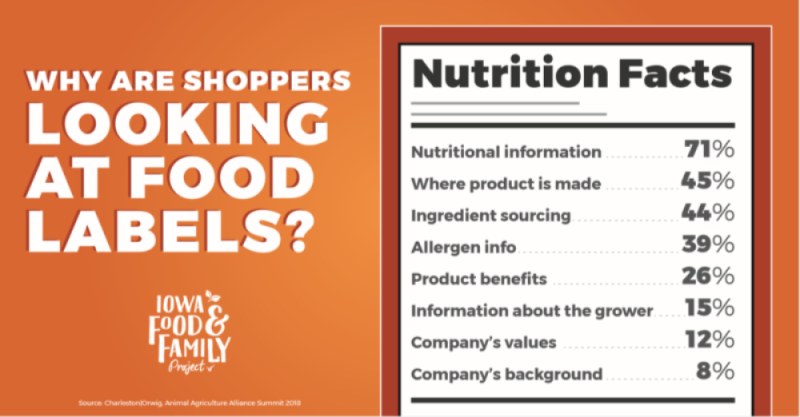Take Food Labels with a Grain of Salt
May 18, 2018
By Aaron Putze, APR, Iowa Soybean Association
What information do shoppers value most when glancing at a food label? What messages do they find most compelling? What food trends do people care about most?
Answers to these questions highlighted two days of discussions during a summit of food and agricultural experts held in early May in Washington, D.C.
Increasingly Complex
You’re not alone if you believe food labels are becoming increasingly complex, said Mark Gale, CEO/Partner of Milwaukee-based Charleston/Orwig.
First introduced in 1980 and including limited info, the Nutrition Labeling and Education Act of 1990 added the rectangle box featuring basic calorie and nutritional details. The addition has become a fixture on nearly every food and beverage sold.
“But by 2015, seven simple facts had morphed into 45,” said Gale, an expert on the history of food labeling and consumer interest in them.
“Everything today is much more complicated. Confusion among consumers is real.”
Food labels have evolved from accurately listing the contents to featuring claims about how the product can improve your life and lifestyle.
“They reflect how our relationship with food has evolved over time, from weight management to feel-good to wanting food that enhances one’s lifestyle,” said Gale in comments to nearly 300 attendees of the Animal Agriculture Alliance’s annual Stakeholder Summit.
As labels have evolved, consumers have also become more skeptical of the claims. Seventy-five percent say they don’t entirely trust food labels while just 29 percent say food manufacturers are doing a “good job” in providing desired information.
Yet 41 percent of shoppers admit to being more interested in food labels than they were just two years ago.
Gale and his team at Charleston/Orwig – a company that bills itself as a “dog-friendly, full-service agency involved in every aspect of the food system” – recently surveyed 500 consumers from across the country about their information preferences.
Seventy-one percent of respondents say they look at labels for nutritional information followed by where the product is made (45), ingredient sourcing (44) and allergen information (39). Just 15 percent rely on labels for details about growers while just 12 percent say they use labels to learn more about company practices and values.

What do you care about?
When it comes to food label claims that consumers find most compelling, the same national survey found “locally raised” topped the list (26 percent) followed by “natural” (25), “antibiotic free” (23) and “non-GMO” (21).
“Organic” was cited by just 21 percent of consumers. “Hormone free,” “grass fed,” “cage free” and “free range” were deemed least credible.
“Local and natural are easy for people to grasp psychologically so it’s little wonder they ranked high,” Gale said. “The other attributes are more difficult to define and therefore are less likely to resonate.”
Plant-based protein is gaining traction among consumers, a trend Gale said is worth watching.
Twenty percent of respondents ages 18-24 are interested in plant based protein vs. 3 percent of those ages 55-64.
“Young audiences are certainly influenced by plant-based options so expect to see more of them,” Gale said.
He also predicts food manufacturers will seek to offer labels providing greater clarity and simplicity to reach more consumers and reduce confusion.
One thing you can count on, however, is the trustworthiness of farmers, said Gale.
“Food in America is as abundant, healthful and safe as it’s ever been. That’s a national story.”
And one that would make a terrific addition to every food label!
Aaron Putze serves as Communications Director for the Iowa Soybean Association and contributor to the Iowa Food & Family Project. He can be reached at aputze@iasoybeans.com.